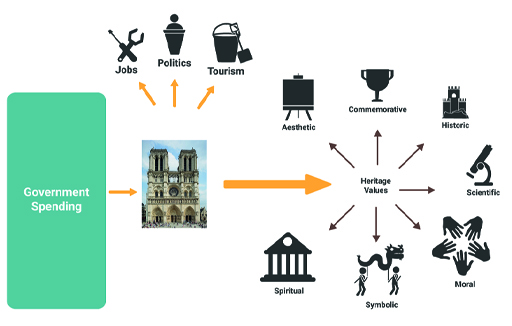2.4 The heritage value justification for rebuilding
The economic justification for rebuilding does not challenge the claim that human beings’ value should always take priority over the value of cultural heritage. Rather, it tries to show how acting to benefit cultural heritage could be the best way to help human beings, given the potential effects it could have on tourism and employment, and the collection of additional tax revenue.
However, some people might believe that the economic justification demonstrates a limited understanding of the true worth of cultural heritage. Although it can produce many economic benefits, to think that cultural heritage is only valuable in these ways would be narrow-minded.
Many varieties of heritage value have been identified in cultural heritage sites such as Notre-Dame, including:
- aesthetic value – its beauty or visual appeal
- commemorative value – its role as evidence or as a memorial to a person or an event
- historical value – the information it contains about important historic events or time periods
- scientific value – its capacity to produce new knowledge for scientists or other scholars
- moral value – derived through ethical relationships (e.g. it may deserve protection as the culmination of many lives’ work or teach us an important lesson – a warning against repeating past mistakes)
- associative/symbolic value – derived through symbolic connection to certain ideals or concepts
- spiritual value – its significance as a religious site or artefact; the role it plays in spiritual practices.
We can now develop and enrich Figure 14 (on the previous page) to get Figure 15. When calculating the value that could be gained by restoring Notre-Dame, we should broaden our scope to include these heritage values, as well as the economic benefits acknowledged previously.
The existence of these valuable features provides another potential justification for rebuilding Notre-Dame. These heritage values are significant, at least in Notre-Dame’s case. Therefore, we should spend money to repair the cathedral because it would be a good thing in itself, independently of the economic benefits that might also be produced.
Indeed, this justification is perhaps what President Macron had in mind when he asserted that the project would go ahead because it is ‘what our history deserves’. Notre-Dame holds a massive amount of value in its own right, and that heritage value alone is enough to justify the expense involved in its repair.

